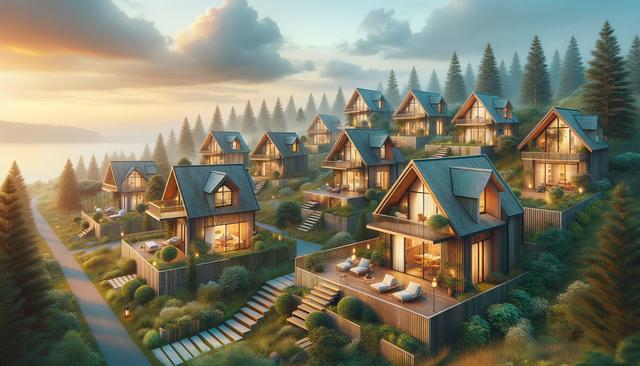Why Choose a Small Prefab Home?
Small prefab homes offer a unique blend of affordability, sustainability, and convenience. Unlike traditional homes that require months of onsite construction, prefab homes are manufactured offsite and assembled quickly, often within days. This streamlined process reduces construction waste and minimizes disruption to natural environments. Additionally, small prefab homes are designed with space efficiency in mind, making them ideal for individuals, couples, or small families who prioritize function over excess.
Many small prefab homes come with customizable layouts and modern design features that maximize every inch of space. For instance, multi-functional furniture, built-in storage, and open floor plans are common elements that enhance usability. These homes are also often built using eco-conscious materials and energy-efficient systems, appealing to those looking to reduce their environmental footprint. Whether placed on a remote plot of land or within a suburban setting, small prefab homes provide a flexible and scalable housing option.
Modern Minimalist Designs
Today’s small prefab homes are a far cry from the plain, box-like structures of the past. Many manufacturers focus on sleek, minimalist designs that combine aesthetics with functionality. These homes often feature clean lines, large windows, and open-concept interiors that create a sense of spaciousness despite their compact size.
Some of the most popular minimalist prefab models include:
- One-bedroom layouts with integrated kitchen and living areas
- Loft-style homes with elevated sleeping areas
- Compact units with outdoor decks and sliding glass doors
Such models are ideal for people who appreciate modern design but want to live simply. In addition to visual appeal, minimalist prefab homes are typically easy to maintain. The use of durable materials and efficient layouts reduces upkeep and allows homeowners to focus more on living than managing household chores.
Eco-Friendly and Energy Efficient
One major advantage of small prefab homes is their potential for energy efficiency. Many of these homes are built using sustainable materials and can be outfitted with solar panels, energy-efficient windows, and insulation that reduces heating and cooling needs. Some models even incorporate passive solar design principles, where the home’s orientation and window placement help regulate indoor temperatures naturally.
Here are some common eco-friendly features found in small prefab homes:
- Low-VOC paints and finishes
- Recycled or renewable building materials
- Rainwater harvesting systems
- LED lighting and energy-star appliances
Choosing a prefab home with these features can lead to long-term cost savings while also supporting a more sustainable lifestyle. This makes small prefab homes especially appealing to environmentally conscious buyers who want to minimize their carbon footprint without sacrificing comfort or style.
Affordability and Financing Options
Affordability is a key factor driving the popularity of small prefab homes. Because they are manufactured in a controlled environment, the costs associated with labor, materials, and construction delays are significantly reduced. As a result, these homes can often be purchased at a lower price than comparably sized traditional homes.
Financing options for prefab homes have also improved in recent years. Many lenders now offer specific loan products for prefab construction, including:
- Construction-to-permanent loans
- Personal loans for small-scale builds
- FHA or VA loans (in some cases)
Buyers should work with lenders who are familiar with the prefab home market to ensure the financing process goes smoothly. It’s also advisable to research local zoning laws and building codes to avoid unexpected challenges. Overall, the financial accessibility of small prefab homes makes them a practical option for first-time homebuyers, downsizers, or those seeking a secondary residence.
Versatility in Placement and Use
Small prefab homes are incredibly versatile in terms of where and how they can be used. Whether you’re looking for a permanent residence, a guest house, or a vacation cabin, prefab structures can be adapted to meet a variety of needs. Their compact size makes them suitable for urban lots, rural properties, and even off-grid locations.
Common uses for small prefab homes include:
- Primary residences in high-cost housing markets
- Accessory dwelling units (ADUs) for rental income or family members
- Remote cabins for seasonal use
- Studio or office spaces separate from the main home
Because they can be relocated or expanded, small prefab homes also offer long-term flexibility. For example, a homeowner might start with a single-module unit and add additional modules later as their needs change. This scalability allows for housing solutions that evolve with life stages and budgets, making prefab homes a future-proof choice for many.
Conclusion: Is a Small Prefab Home Right for You?
Small prefab homes present a compelling alternative to traditional housing, offering modern design, energy efficiency, and financial accessibility. They are especially appealing for those seeking a simpler lifestyle, a smaller environmental footprint, or a flexible living arrangement. Whether you’re a first-time homebuyer, a retiree looking to downsize, or someone in need of an additional space on your property, exploring the world of prefab homes could open up a range of possibilities. As the demand for sustainable and efficient housing grows, small prefab homes continue to stand out as a smart and stylish solution.


